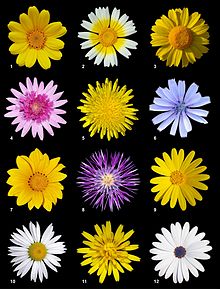
In botany, a fruit is the seed-bearing structure in flowering plants that is formed from the ovary after flowering.

The waxwings are three species of passerine birds classified in the genus Bombycilla. They are pinkish-brown and pale grey with distinctive smooth plumage in which many body feathers are not individually visible, a black and white eyestripe, a crest, a square-cut tail and pointed wings. Some of the wing feathers have red tips, the resemblance of which to sealing wax gives these birds their common name. According to most authorities, this is the only genus placed in the family Bombycillidae, although sometimes the family is extended to include related taxa that are more usually included in separate families: silky flycatchers, Hypocolius (Hypocoliidae), Hylocitrea (Hylocitreidae), palmchats (Dulidae) and the Hawai'ian 'honeyeaters' (Mohoidae). There are three species: the Bohemian waxwing, the Japanese waxwing and the cedar waxwing.
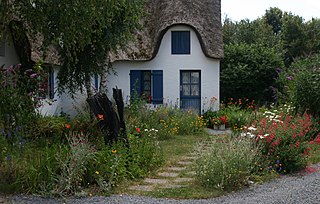
A wildlife garden is an environment created with the purpose to serve as a sustainable haven for surrounding wildlife. Wildlife gardens contain a variety of habitats that cater to native and local plants, birds, amphibians, reptiles, insects, mammals and so on, and are meant to sustain locally native flora and fauna. Other names this type of gardening goes by can vary, prominent ones being habitat, ecology, and conservation gardening.

Magnolia grandiflora, commonly known as the southern magnolia or bull bay, is a tree of the family Magnoliaceae native to the Southeastern United States, from Virginia to central Florida, and west to East Texas. Reaching 27.5 m (90 ft) in height, it is a large, striking evergreen tree, with large, dark-green leaves up to 20 cm long and 12 cm wide, and large, white, fragrant flowers up to 30 cm (12 in) in diameter.
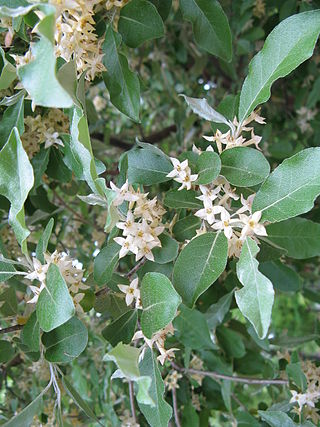
Elaeagnus umbellata is known as Japanese silverberry, umbellata oleaster, autumn olive, autumn elaeagnus, spreading oleaster,. or autumnberry or autumn berry. The species is indigenous to eastern Asia and ranges from the Himalayas eastwards to Japan. It is a hardy, aggressive invasive species able to readily colonize barren land, becoming a troublesome plant in the central and northeastern United States and Europe.

Rudbeckia hirta, commonly called black-eyed Susan, is a North American flowering plant in the family Asteraceae, native to Eastern and Central North America and naturalized in the Western part of the continent as well as in China. It has now been found in all 10 Canadian Provinces and all 48 of the states in the contiguous United States.

Dasiphora fruticosa is a species of hardy deciduous flowering shrub in the family Rosaceae, native to the cool temperate and subarctic regions of the northern hemisphere, often growing at high altitudes in mountains. Dasiphora fruticosa is still widely referenced in the horticultural literature under its synonym Potentilla fruticosa. Common names include shrubby cinquefoil, golden hardhack, bush cinquefoil, shrubby five-finger, widdy, and kuril tea.

Allium vineale is a perennial, bulb-forming species of wild onion, native to Europe, northwestern Africa and the Middle East. The species was introduced in Australia and North America, where it has become a noxious weed.

Washingtonia is a genus of palms, native to the southwestern United States and northwest Mexico. Both Washingtonia species are commonly cultivated across the Southern United States, the Middle East, southern Europe, and North Africa, where they have greatly hybridized.

Banana passionfruit, also known as taxo and curuba, is a group of around 64 Passiflora species found in South America. Most species in this section are found in high elevation cloud forest habitats. Flowers have a cylindrical hypanthium.
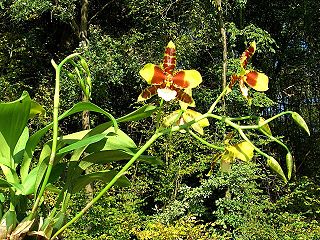
Rossioglossum grande, one of several species known as tiger orchids, is an epiphytic orchid native to the area from Chiapas to Costa Rica. The plant may grow four to eight flowers, each up to 13 inches in diameter. The flowers are a glossy bright golden yellow with brown barring. Larger petals are yellow with the lower half red-brown. The lip is white and sometimes flecked with red-brown. The pseudobulbs are gray-green in color, and grow from 4 to 10 cm, each with two leaves.

Opuntia stricta is a species of large cactus that is endemic to the subtropical and tropical coastal areas of the Americas, especially around the Caribbean. Common names include erect prickly pear and nopal estricto (Spanish). The first description as Cactus strictus was published in 1803 by Adrian Hardy Haworth. In 1812 he moved the species to the genus Opuntia.

Ligustrum ovalifolium, also known as Korean privet, California privet, garden privet, and oval-leaved privet, is a species of flowering plant in the olive family Oleaceae. The species is native to Japan and Korea.
Aphandra is a monotypic genus of flowering plant in the palm family native to the Amazon rainforest vegetation in South America. Its only species is Aphandra natalia, sometimes called mastodon palm or fiber palm, and is used by indigenous peoples in the construction of brooms and other products. This plant is commercially exploited for its edible fruits, and for its leaf sheath and petiole fibers. This fiber is almost equal to the fiber extracted from Attalea funifera and Leopoldinia piassaba, which is called piassava.

Helianthus maximiliani is a North American species of sunflower known by the common name Maximilian sunflower.
Little brown bird (LBB) or little brown job (LBJ) is an informal name used by birdwatchers for any of the large number of species of small brown passerine birds, many of which are notoriously difficult to distinguish. This is especially true for females, which lack much of the differentiating coloring present in males.
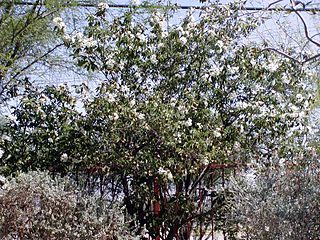
Cordia boissieri is a white-flowered, evergreen shrub or small tree in the borage family (Boraginaceae). Its native range extends from southern Texas in the United States south to central Mexico. Common names include anacahuita, Mexican olive, white cordia, and Texas wild olive. It is named after the Swiss explorer and botanist Pierre Edmond Boissier.

Cylindropuntia leptocaulis, the desert Christmas cactus, desert Christmas cholla, pencil cactus, or tasajillo, is a species of cholla cactus.

Exochorda racemosa, the pearlbush or common pearlbush, is a species of plant in the family Rosaceae. This species is mostly found in China and Japan.
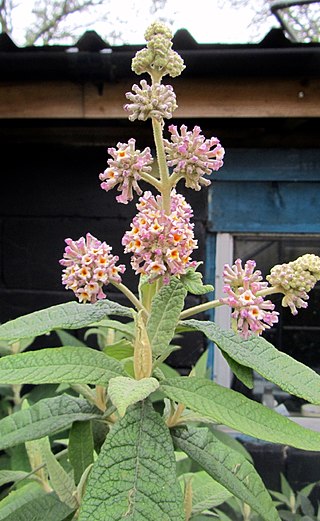
Buddleja 'Winter Sun' is a British cultivar raised by Steve Nevard, London, from a crossing of B. araucana and B. officinalis. 'Winter Sun' is a winter / early spring flowering shrub of similar size and vigour to B. officinalis. It has pink-flushed-yellow flowers in terminal clusters of small globose heads, complemented by olive green foliage with a brown tomentose underside.
